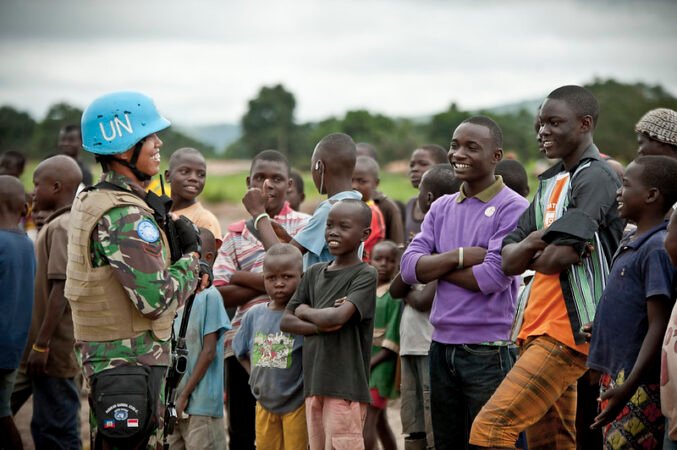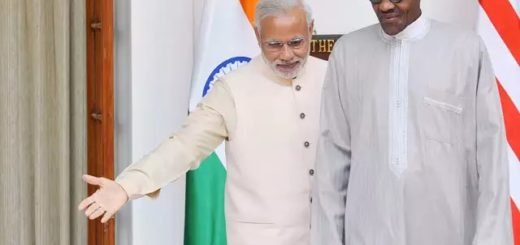Use of Force in and Protection of Civilians

Introduction
Protecting civilians is the UN’s priority objective. Although it is the primary responsibility of the host state to protect its people, the peacekeepers have the moral responsibility to protect innocent civilians from the danger and violence of the conflicts. Most current UN peace operations are mandated to protect civilians by using all means including the use of force. However, even after being empowered to use force, the protection of civilians has remained a challenge. This brief essay aims to examine whether there is a utility in using force to protect civilians.
Protection of Civilians and PoC Mandate
The PoC mandate in UN peacekeeping is grounded in international laws and provides legal authority to the peacekeepers.[1] United Nations Assistance Mission in Rwanda (UAMIR) was the first mission to get a mandate to contribute to the security and protection of displaced persons, refugees, and civilians at risk in Rwanda. But it was only after the mission was almost withdrawn. UNAMSIL was the first mission that explicitly authorised the proactive use of force to protect civilians under imminent threat of physical violence.[2]
Development of the UN System and Evolution of Use of Force
The application of force to protect civilians evolved along with the development of the UN System and the evolution of force from the use of minimum force under Chapter VI to the use of all necessary means under Chapter VII. The UN which was established as a replacement for the League has the authority and responsibility to ensure international peace and security including using all means under Chapter VII but does not have any standing peacekeeping force under its command to impose such an authority. Hence, even though the UN was expected to plug the gaps in the League, it too had to look to the member states to contribute troops to both enforce peace and supervise ceasefire agreements. The UN was conceived on the premise of respecting state sovereignty as mentioned in the Westphalian System, which was reflected in Article 2 (1) of the UN Charter.[3] The UN peacekeeping which incidentally doesn’t find any reference in the UN Charter, was born out of necessity and established to create conditions for settling disputes between states peacefully as mentioned in Article 2(3) of the UN Charter. United Nations Truce Supervision Organisation (UNTSO) is the first peacekeeping mission established on 29 May 1948. Another development of the post-Cold War that is critical to the evolution of the use of force is the UN’s disasters in Somalia, Rwanda, and the former Republic of Yugoslavia. It prompted the UN to recognise the need to formalise PoC as part of the mandate and development of R2P. However, lack of clarity in the conceptual thinking of the use of force posed a challenge to operationalising PoC. The Agenda for Peace of 1992 followed by the Brahimi Report and High-Level Independent Panel Report (HIPPO) brought some clarity to the thinking on using force.[4] The Cruz Report has been strongest in its opinion about the use of force.[5]

Why do Peacekeepers hesitate to use force?
PoC and Principle of Peacekeeping: Amongst the many challenges that the PoC mandate faces, it seems to act at cross purposes with the principles of peacekeeping.[6] The first principle of a peacekeeping operation is consent. But consent is not absolute, it is conditional, and it would be withdrawn if the conditions are diluted.[7] At times when against the host states who might be complicit in the crimes, consent becomes precarious and any action against the host state might end up host state withdrawing its consent. As an illustration, in July 2016, when the government soldiers of South Sudan stormed the Terrain Hotel which housed most international civilian employees and used violence against them, the United Nations Mission in South Sudan (UNMISS) was found wanting.[8]
The principle of impartiality is linked to the availability of consent from all parties to the conflict. Amid conflicts, where there are several parties to conflict, the UN’s impartial stance toward one party may be considered partial by another party. In a stabilisation mission like the United Nations Organization Stabilization Mission in the Democratic Republic of the Congo (MONUSCO), since the mission is in support of the host government, targeting non-state actors in support of the host state is perceived as partial to the host state.[9] It is an ethical dilemma especially when it comes to acting against the host state because of fear of withdrawal of consent.
The Security Council authorising ‘use of all necessary means’, under Chapter VII, has legal implications as it can be interpreted to use even lethal force. Using lethal force may exaggerate violence (when retaliated by the other side) and encourage vengeance while reducing the scope of dialogue. Besides this, there might be some unintended consequences on the peace process such as jeopardising other important goals and objectives of the mission; an increase in cases of peacekeepers abusing their authority and an impact on local HR situations. That apart, on one hand, it protects civilians and on the other hand, it increases vulnerability to both peacekeepers and civilians.[10]
Ambiguity in Phraseology: There is ambiguity in the interpretation of the use of force.[11] For example, what does the defence of mandate entail? Does it include pre-emptive or offensive measures or is there a limit to escalation? What is the meaning of self-defence and what is the quantum of force that can be considered as minimum? These are difficult questions to answer. Such ambiguity becomes a restraining factor for CIVPOL as well. For example, ‘using all necessary means’ can be confusing since CIVPOL doesn’t have the executive mandate to arrest and detain.[12]
Ambiguous PoC Policy: The latest UN policy of 2023 which is an updated and revised version of the earlier version of the policy of 2019, has reemphasised the PoC operational concept in three-tier action.[13] Despite that the report of 2023 is exhaustive and more detailed than the previous one, the peacekeepers may have a different understanding of the norm. For example, one of the guiding principles of PoC mandates that the protection of civilians must be fully consonant with the three principles of peacekeeping. Where there is ambiguity in the understanding of the principles of peacekeeping, some of the guidelines in the new policy also become ambiguous. Academicians’ views can also be problematic creating confusion and resulting in hesitancy in using force by some peacekeepers, ignoring their moral obligation to protect innocent lives.
Lack of Will and Inadequate Resources: Lack of willingness on the part of the TCCs to accept risks (fall out of using force) combined with inadequate resources restrain peacekeepers from using force proactively. When the density of peacekeepers is thin, the strategy of deterrence by the threat to use force or the strategy of pre-emption to provide passive protection does not work, and it becomes difficult to garner force to match the violence properly.[14]
PoC vs R2P: The concept of PoC and R2P are both grounded in the need to protect civilians. Therefore, both are linked and have similarities.[15] On the other hand, R2P is a political principle designed to prevent genocide, war crimes, crimes against humanity and ethnic cleansing. The complex relationship generates debates and controversies and a lack of understanding of the difference poses a challenge to when operationalising PoC.
Utility of the Use of Force to Protect Civilians
Despite the challenges in using force to protect civilians, there are instances of commanders using force to protect civilians. The first example dates to as early as the 1990s, much before the PoC had become the core objective of the UN. In Srebrenica, in December 1993, one platoon of NORDBAT 2, despite being heavily outnumbered by a Croatian battalion-size force, refused to hand over two Muslim nurses to the Croats for more than 12 hours. In another one out of many incidents in South Sudan, when an internal communal clash broke out in Malakal on 18 February 2014, Indian peacekeepers, disregarding their safety positioned themselves in between armed groups and prevailed upon to find a solution using means other than violence. There must be many more such examples of peacekeepers using force to protect civilians. These two examples show that regardless of formal authorisation of the use of force to protect civilians, peacekeepers can use all necessary means to protect civilians to fulfil their moral obligation.
Conclusion
Even much before the PoC formally became part of the mandate (explicitly authorising proactive use of force) for UN peace operations from the time of UNAMSIL PoC was inherent in the mandate because it is the moral responsibility of the peacekeeper to save civilians. Operational military commanders at tactical levels don’t have the luxury of self-education about the prevailing rules and regulations like the academicians and policymakers. In battle, there are fleeting moments when the commanders must make quick life-and-death decisions that need to be informed by IHL compliance. When the peacekeepers follow the fundamental principles of HL Humanity, Distinction, Proportionality and Military Necessity, and think on their feet to make informed decisions, using force to protect civilians will be in good faith.[16] Unless commanders at tactical levels are constantly reminded of their moral responsibility and encouraged to take the initiative to protect the ones in danger and states make it their obligation to protect the protectors, innocent civilians will continue to suffer.
[1] “Policy: The Protection of Civilians in United Nations Peacekeeping,” UN Department of Peace Operations, Ref.2023.05, May 1, 2023.
[2] UN, S/RES/1289 (2000) 7 February 2000
[3] Steven Patton, “The Peace of Westphalia and its Affects on International Relations, Diplomacy and Foreign Policy,” The Histories, Vol. 10 No.1 Article 5,2019,
https://digitalcommons.lasalle.edu/the_histories/vol10/iss1/5
[4] UN General Assembly Security Council, Agenda for Peace, A/47/277 – S/24111 (June 17, 1992); UN General Assembly, Report of the Panel on United Nations Peace Operations, A/55/305-S/2000/809 (August 21, 2000); United Nations Peacekeeping Operations: Principles and Guidelines (New York: UN Department of Peacekeeping Operations, 2008), pp. 31 and High Level Independent Panel Report A/70/95–S/2015/446, 17 June 2015
[5] Lieutenant General (Retired) Carlos Alberto dos Santos Cruz, “Improving Security of United Nations
Peacekeepers: We need to change the way we are doing business,” December 19, 2017, https://peacekeeping.un.org/sites/default/files/improving_security_of_united_nations_peacekeepers_report.pdf. Also see, Paul D Williams, “Cruz Report: The Politics of Force and the United Nations’ Peacekeeping Trilemma,” February 9, 2018, https://theglobalobservatory.org/2018/02/cruz-report-peacekeeping-trilemma/
[6] United Nations Peacekeeping Operations: Principles and Guidelines (New York: UN Department of Peacekeeping Operations, 2008), pp. 31.
[7] “Host-Country Consent in UN Peacekeeping: Bridging the Gap between Principle and Practice,” Peacekeeping, Stimson, September 8, 2022, https://www.stimson.org/2022/host-country-consent-in-un-peacekeeping-bridging-the-gap-between-principle-and-practice/. Also see, Anjali Dayal, “A Crisis of Consent in UN Peace Operations,” IPI Global Observatory, August 2, 2022, https://theglobalobservatory.org/2022/08/a-crisis-of-consent-in-un-peace-operations/
[8] Lauren Spink and Matt Wells, “Under Fire: The July 2016 Violence in Juba and UN Response,” Centre for Civilians in Conflict, October 5, 2016, https://civiliansinconflict.org/publications/research/fire-july-2016-violence-juba-un-response; “ UN: Rape used as a tool for ethnic cleansing in South Sudan,” CBS News, December 2, 2016, https://www.cbsnews.com/news/united-nations-says-rape-used-as-tool-for-ethnic-cleansing-in-south-sudan/
[9] UN Security Council Resolution, S/RES/2666 (2022), December 20, 2022. For more details on stabilisation, please see Cedric de Coning, “Is stabilization the new normal? Implications of stabilization mandates for the use of force in UN peace operations,” in The Use of Force in UN Peacekeeping (1st ed.) ed. Peter Nadin (London: Routledge, 2018).
[10] For details of casualty to peacekeepers, see. UN Security Council Resolution S/RES/2589 (2021), August 18, 2021
[11] A K Bardalai, “UN Peacekeeping and Ambiguity in Normative UN Norms,” Manohar Parrikar Institute for Defence Studies and Analyses Journal of Defence Studies, Vol. 16, No. 3, July–September 2022, pp. 3–31
[12] Charles T. Hunt, “To serve and protect: The changing roles of police in the protection of civilians in UN peace operations,” Civil Wars, September 21, 2022, DOI: 10.1080/13698249.2022.2119507
[13] “Policy: The Protection of Civilians in United Nations Peacekeeping,” UN Department of Peace Operations, Ref.2023.05, May 1, 2023. Also see, “The Protection of Civilians in United Nations Peacekeeping”, The UN Department of Peace Operations, Ref. 2019.17. November 1, 2019
[14] Stian Kjeksrud, “Utility of Force to Protect Civilians from Violence: Violence: Exploring Outcomes of United
Nations Military Protection Operations in Africa (1999–2017),” Civil Wars, https://doi.org/10.1080/13698249.2023.2222058
[15] “Policy: The Protection of Civilians in United Nations Peacekeeping,” UN Department of Peace Operations, Ref.2023.05, May 1, 2023.
[16] For more details on the Fundamental Principles of IHL, see, https://casebook.icrc.org/a_to_z/glossary/fundamental-principles-ihl


















